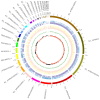Insights into Brevibacillus borstelensis AK1 through Whole Genome Sequencing: A Thermophilic Bacterium Isolated from a Hot Spring in Saudi Arabia
- PMID: 29992154
- PMCID: PMC5994324
- DOI: 10.1155/2018/5862437
Insights into Brevibacillus borstelensis AK1 through Whole Genome Sequencing: A Thermophilic Bacterium Isolated from a Hot Spring in Saudi Arabia
Abstract
Brevibacillus borstelensis AK1 is a thermophile which grows between the temperatures of 45°C and 70°C. The present study is an extended genome report of B. borstelensis AK1 along with the morphological characterization. The strain is isolated from a hot spring in Saudi Arabia (southeast of the city Gazan). It is observed that the strain AK1 is rod-shaped, motile, and strictly aerobic bacterium. The whole genome sequence resulted in 29 contigs with a total length of 5,155,092 bp. In total, 3,946 protein-coding genes and 139 RNA genes were identified. Comparison with the previously submitted strains of B. borstelensis strains illustrates that strain AK1 has a small genome size but high GC content. The strain possesses putative genes for degradation of a wide range of substrates including polyethylene (plastic) and long-chain hydrocarbons. These genomic features may be useful for future environmental/biotechnological applications.
Figures



Similar articles
-
Draft Genome Sequence of Brevibacillus borstelensis cifa_chp40, a Thermophilic Strain Having Biotechnological Importance.J Genomics. 2016 Feb 15;4:4-6. doi: 10.7150/jgen.14036. eCollection 2016. J Genomics. 2016. PMID: 26958091 Free PMC article.
-
Genome Sequence of Anoxybacillus flavithermus Strain AK1, a Thermophile Isolated from a Hot Spring in Saudi Arabia.Genome Announc. 2015 Jun 4;3(3):e00604-15. doi: 10.1128/genomeA.00604-15. Genome Announc. 2015. PMID: 26044438 Free PMC article.
-
Genomic comparison of anoxybacillus flavithermus AK1, a thermophilic bacteria, with other strains.Enzyme Microb Technol. 2019 Dec;131:109385. doi: 10.1016/j.enzmictec.2019.109385. Epub 2019 Jul 19. Enzyme Microb Technol. 2019. PMID: 31615674
-
Culturomics-Based Taxonomic Diversity of Bacterial Communities in the Hot Springs of Saudi Arabia.OMICS. 2019 Jan;23(1):17-27. doi: 10.1089/omi.2018.0176. Epub 2018 Dec 27. OMICS. 2019. PMID: 30589606
-
Survey of the transcriptome of Brevibacillus borstelensis exposed to low temperature shock.Gene. 2014 Oct 25;550(2):207-13. doi: 10.1016/j.gene.2014.08.030. Epub 2014 Aug 21. Gene. 2014. PMID: 25151307
Cited by
-
Whole-Genome Sequence of Brevibacillus borstelensis SDM, Isolated from a Sorghum-Adapted Microbial Community.Microbiol Resour Announc. 2020 Nov 25;9(48):e01046-20. doi: 10.1128/MRA.01046-20. Microbiol Resour Announc. 2020. PMID: 33239462 Free PMC article.
-
Effect of Temperature on Acetate Mineralization Kinetics and Microbial Community Composition in a Hydrocarbon-Affected Microbial Community During a Shift From Oxic to Sulfidogenic Conditions.Front Microbiol. 2020 Dec 17;11:606565. doi: 10.3389/fmicb.2020.606565. eCollection 2020. Front Microbiol. 2020. PMID: 33391229 Free PMC article.
-
Microbial diversity in relation to physico-chemical properties of hot water ponds located in the Yamunotri landscape of Garhwal Himalaya.Heliyon. 2020 Sep 6;6(9):e04850. doi: 10.1016/j.heliyon.2020.e04850. eCollection 2020 Sep. Heliyon. 2020. PMID: 32954033 Free PMC article.
-
Insecticidal Activity of Bacteria from Larvae Breeding Site with Natural Larvae Mortality: Screening of Separated Supernatant and Pellet Fractions.Pathogens. 2020 Jun 18;9(6):486. doi: 10.3390/pathogens9060486. Pathogens. 2020. PMID: 32570965 Free PMC article.
-
Assembly strategies for polyethylene-degrading microbial consortia based on the combination of omics tools and the "Plastisphere".Front Microbiol. 2023 Apr 17;14:1181967. doi: 10.3389/fmicb.2023.1181967. eCollection 2023. Front Microbiol. 2023. PMID: 37138608 Free PMC article. Review.
References
-
- Seckbach J. Journey to Diverse Microbial Worlds: Adaptation to Exotic Environments. Springer Science & Business Media; 2000.
-
- Migula W. System der Bakterien. Vol. 2. Jena, Germany: Gustav Fisher; 1900.
-
- Nakamura L. K., Swezey J. Taxonomy of Bacillus circulans Jordan 1890: Base composition and reassociation of deoxyribonucleic acid. International Journal of Systematic Bacteriology. 1983;33(1):46–52. doi: 10.1099/00207713-33-1-46. - DOI
-
- Nakamura L. K., Swezey J. Deoxyribonucleic acid relatedness of Bacillus circulans Jordan 1890 strains. International Journal of Systematic Bacteriology. 1983;33(4):703–708. doi: 10.1099/00207713-33-4-703. - DOI
MeSH terms
LinkOut - more resources
Full Text Sources
Other Literature Sources
Miscellaneous

